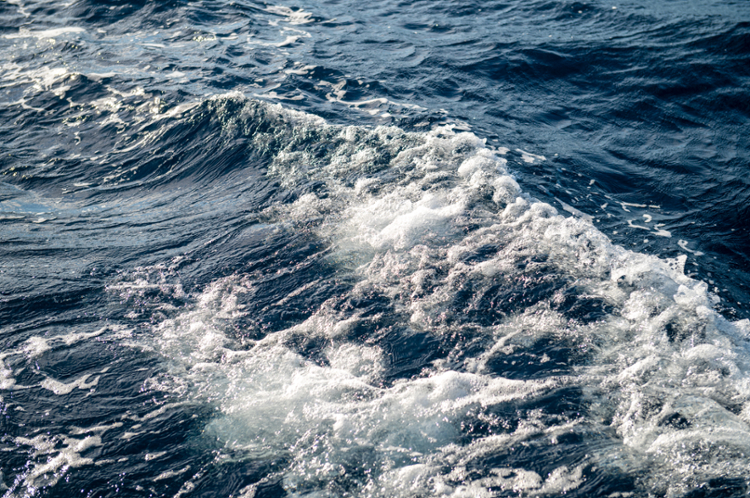HRI Research Cruise Surveys Texas Reefs for Red Snapper Count
CORPUS CHRISTI, Texas – Scientists with the Harte Research Institute for Gulf of Mexico Studies at Texas A&M University-Corpus Christi spent 14 days at sea aboard the R/V Pelican surveying dozens of offshore artificial and natural reef sites in search of a controversial and iconic sportfish species.
The August research cruise was a critical component of the Center for Sportfish Science and Conservation’s Great Red Snapper Count, an independent effort to estimate the number of red snapper in the U.S. waters of the Gulf of Mexico.
“The research cruise coincided with great weather and was a huge success. Our team of scientists really pulled through by collecting some outstanding data,” said HRI Chair for Fisheries and Ocean Health and Sportfish Center Director Dr. Greg Stunz, who is leading the Great Snapper Count. “It’s a lot of hard work and effort, but spending extended days at sea allows our scientists the on-site time needed to address some important management questions regarding Red Snapper abundance.”
The Sportfish Center is leading a team of 21 fisheries experts from across the Gulf and beyond, who are employing a number of scientific tools to reach this estimate, including: habitat classification, visual and acoustic surveys, depletion surveys, and a tagging study.
“It’s rare to have so many research groups across the Gulf using similar methods in the same time frame to answer the same question – that’s what makes this project unique and significant,” said Jennifer Wetz, Sportfish Center Fisheries Program Manager.
One of the primary directives of the project was to estimate Red Snapper populations on three habitat types to try to get a more accurate picture of the population in the Gulf’s diverse environment, said Dr. Matt Streich, Sportfish Center Assistant Research Scientist and chief scientist onboard the research cruise.
Aboard the R/V Pelican, operated by the Louisiana Universities Marine Consortium (LUMCON), the Sportfish Center partnered with a team from Texas A&M University at Galveston to conduct surveys from the upper coast to south Texas.
The Texas A&M Galveston researchers towed sleds mounted with acoustic and camera equipment to measure life and snapper abundance in the open sea bottom habitats. The Sportfish Center crew focused on natural reefs like the Flower Garden banks and artificial reefs like drilling rigs that have created new ecosystems. They used their underwater remotely operated vehicle (ROV), a VideoRay Mission Specialist Defender, to survey the reef by video. The ROV can descend to depths that wouldn’t be safe for dive surveys, in this case up to 150 meters, and allows them to survey marine life that might be frightened by the presence of a human diver. They also conducted acoustic surveys to help determine the biomass – the number of living things – on the reef by using soundwaves to create a picture of the life underwater.
“We’re learning a lot about the distribution of fish by habitat type because that’s been rarely considered in past stock assessments,” Streich said. “Knowing how many fish we’re seeing on these different habitat types, natural versus artificial reefs, for example, will help contribute new knowledge about the fishery.”
A long stretch on the water allowed the Sportfish Center scientists to get plenty of surveying in, visiting 23 artificial and natural reef sites along the coast, but there were also long stretches of downtime while traveling or allowing their partners at Texas A&M-Galveston to do their work. It gave them plenty of time to review the ROV video and count fish for surveys, and also to get a bit of cabin fever.
“It’s a little hard on everyone, you miss your family. More than 10 days on the water gets to be a little tough,” Streich said.
Thankfully, the friendly and professional crew of the R/V Pelican and an ice cream-filled freezer kept their spirits up.
In addition to the visual and acoustic surveys, the Sportfish Center is conducting a reward-based tagging study to help collect data on snapper abundance. Tagged snapper were released across the Gulf Coast before the season opening, and anglers who caught tagged fish could report them for a cash reward. The Sportfish Center experienced an extremely high reporting rate thanks to lucky fishermen, but most importantly the extra data will help them to determine the final Red Snapper population estimate for the U.S. Gulf.
The projected is expected to be completed in February.
Red Snapper are one of the most highly targeted and controversial fish species in the northern Gulf. Considered overfished since the 1980s, anglers saw dramatic reduction in both the fishing season and bag limits in recent decades. Challenges in collecting data on the number of Red Snapper in the Gulf of Mexico was considered part of the problem, leading to the commissioning of this independent study by Congress.
“Our research is important because it’s providing an independent abundance assessment on the population of Red Snapper in the U.S. waters of the Gulf of Mexico,” Streich said. “It will serve as an alternative estimate to compare to the assessment models from NOAA Fisheries.”








